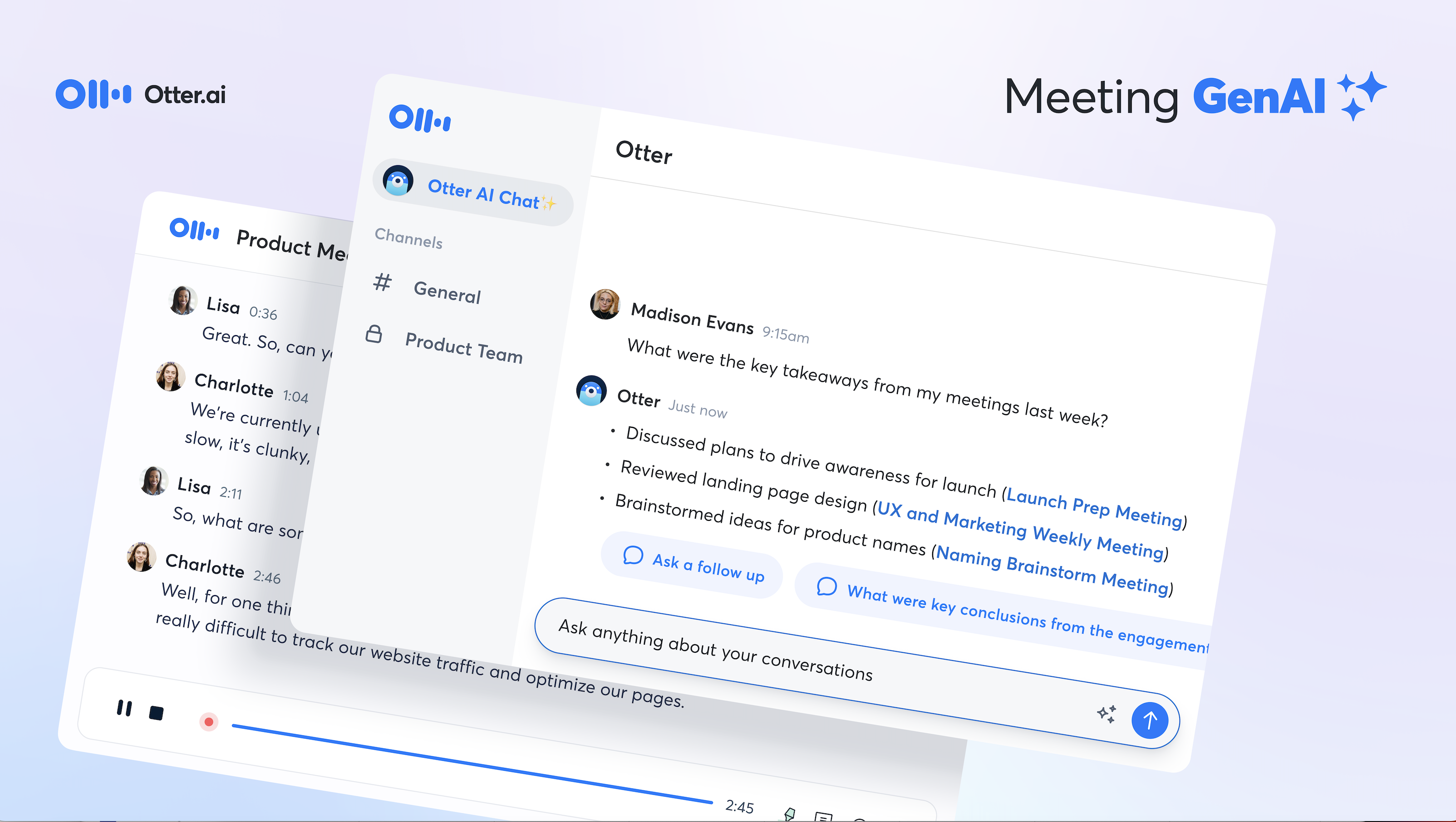Zoom meetings present a completely new social environment for people who are not accustomed to video calling. Even if you do make video calls on a regular basis, you may feel out of your element in a Zoom meeting with small groups or significant audio delays. In any case, there’s no need to feel awkward or unsociable in virtual meetings. The shift to remote work is a major transition for everyone, so you’re not alone.
Nonetheless, there are issues associated with virtual meetings that can leave people feeling disconnected, unproductive, or even overworked. ‘Zoom fatigue’ is a real phenomenon in which people feel especially tired from frequent interaction via video chat. Fortunately, Otter.ai offers a few unique benefits to help combat Zoom fatigue and make video calls a lot easier to manage.
Deciding to Use Virtual Ice Breakers
Before we take a look at 5 virtual ice breakers for your next Zoom team meeting, it’s important to decide whether or not you need ice breakers. While they can make some meetings run much more smoothly, they could be a waste of time in certain situations. So, here are a few scenarios in which ice breakers could help you out:
- You’re gathering a new team of remote workers together for the first time
- There are one or more new team members attending the meeting
- You have one or more participants who have struggled to contribute during virtual team meetings in the past
- You’re conducting a virtual meeting in which the agenda is vague or undetermined
- The meeting is centered on socialization, remote team-building, increasing team collaboration, or generally improving team rapport
While this may not represent a comprehensive list of every time you could use virtual ice breakers, the situations above are some of the most common ones you’ll encounter. Alternatively, here are a few situations in which virtual ice breakers are largely unnecessary:
- Your team or coworkers have been working together for a while and all team members know each other very well
- No team member has struggled to contribute or be sociable during past virtual meetings
- You have limited time to address important topics
So, before you start using any virtual team ice breakers, make sure that you actually need them!
Kicking Off a Virtual Meeting
While we will expound on specific virtual meeting ice breakers a little later on, it’s important to note the importance of starting a meeting off on the right foot. Many times, managers or team leaders don’t need ice breakers, they simply need good ways to get a meeting started. Here are a few ways to kick off your virtual meetings with general questions and phrases:
- Thank you all for attending! If it’s alright with everyone, I’d like to get right down to business.
- Before we get started, does anyone have any questions or concerns?
- I’d like for everyone to give me a quick update on the status of [projects, tasks, etc].
- Did anyone do anything fun this weekend?
- We don’t have a lot of items to cover today, so we can probably keep this meeting pretty brief.
- How is everyone’s day going so far?
- We have a lot to cover in this meeting, so I’d like to get started so that we can wrap things up at a reasonable time.
The questions and phrases above will kick off just about any kind of meeting, regardless of your team’s individual circumstances. However, if you really want to help promote socialization or welcome new colleagues, virtual team ice breakers are a must.
Top 5 Ice Breakers for Virtual Meetings
Now let’s take a look at a few virtual ice breakers that go beyond the introductory questions and phrases above:
Ask for personal introductions
This is a pretty standard operating procedure for Zoom meeting managers. When you’re gathering a new team or have at least one new member, it’s polite to have everyone briefly introduce themselves to the group. Not only does this help get people talking, but it also helps team members know who is actually in the meeting. Since some people may feel a little shy or unsure of what to say, you can introduce yourself first. If people are still struggling to contribute, you can list a few specific things for them to mention, including:
- Name
- Position or responsibilities in the team
- Location (can vary widely with remote employees)
- An interesting fact about themselves
- Non-invasive facts about their personal lives (children, pets, siblings, etc.)
- Background information about their work or life experiences prior to joining the team
Do the Zoom background challenge

One interesting and fun feature of Zoom is the ability to change your background. While this is also available with other video conferencing platforms like Microsoft Teams and Google Hangouts, Zoom makes it so that you can change your background to pretty much anything. Functionally, this can help people attend meetings in just about any “setting,” while hiding messy or unprofessional backgrounds.
So, why not have fun with the feature? There are no specific rules to the ‘Zoom background challenge,’ which means you can cater this team-building exercise to your tastes or your team members’ personalities. That said, the general idea is to challenge each team member to find the funniest or most interesting background and use it for the remainder of the meeting. This will help lighten the mood and get the creative juices flowing at the same time.
Create a team or general trivia quiz

A team trivia quiz tests your team members’ knowledge of one another. This one is better if you have a team that’s been together for at least a few months. Example topics for questions could include:
- Favorite movie, tv shows, food, vacation spot, musical artist, author, etc.
- Hobbies
- Hometown
- First job
- Zodiac sign
- Pet peeves
- Biggest fear
- Greatest accomplishment
Though this is better to do with team members who have known each other for a while, it can also work with a brand new team. Since people are not expected to know the answers, they can take their best guesses and have fun with it. When you reveal the true answers, you’ll help your team members learn more about one another and feel more comfortable together.
Alternatively, if you don’t want to get into personal information, you can just do a general trivia quiz. You can ask questions about pop culture, history, geography, business, movies, music, animals, sports, or just about any topic that interests you. This kind of game is popular and will help team members showcase their knowledge in different areas.
Play charades or other word-guessing games
Another fun and unique way to get people talking is to play charades or similar word-guessing games. Generally, the charades game involves one person acting out a word (without speaking) and having one or more people try to guess the word. You can divide people into teams or just allow everyone to guess at the same time. As the remote meeting leader, you can send an individual a private message with a list of words that they need to act out. Then, you can set a timer. Once the timer is done, you count how many words people were able to correctly guess. The team or person with the most correctly-guessed words wins.
However, you may want to choose a game that won’t alienate people who prefer not to act things out. Instead, you can play an altered version of Taboo. The structure of the game is the same as charades, but instead of acting words out, players must describe words without referring to specific letters or syllables. This is yet another great way to get people talking and having fun together.
Introduce Your Team to Fika

If you haven’t heard of Fika, it is the Swedish tradition of having a relaxing coffee break. Fika can be done alone or in groups, so it is a perfect way to have your team get to know each other without any rules or stipulations. Let your team know that there are no obligations. You’re simply relaxing and socializing over a cup of coffee (or tea).
Often times, when people know that the environment is relaxed and there are no expectations, they feel more compelled to speak up and get to know their fellow teammates. As opposed to games or other types of virtual ice breakers that have specific rules, Fika is all about taking a “moment to slow down and appreciate the good things in life.” So, if you don’t want to obligate your team to do anything that takes them outside of their comfort zone, a Fika might be the perfect solution.
Conclusion
Finding a way to break the ice between team members is about more than just socializing. Team members who feel comfortable with each other are more likely to go the extra mile to help their team, thereby increasing productivity and general cohesion. While you won’t need virtual ice breakers for every team meeting, they can be extremely useful for building lasting bonds and working relationships between new team members.
Do you want to learn more about the perks of Otter.ai for building and managing distributed teams? Contact Otter.ai today for more information!







